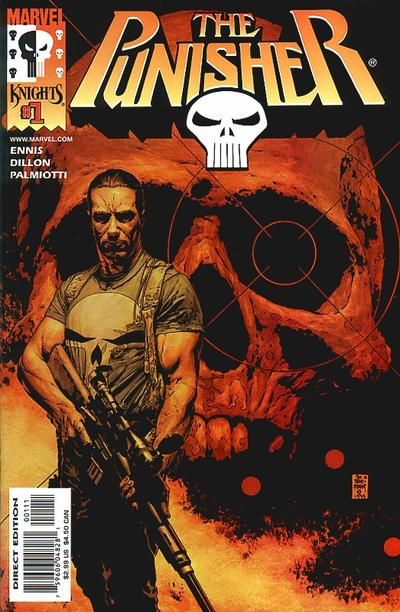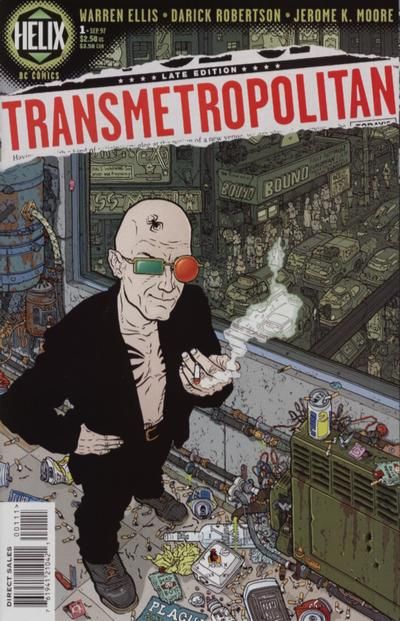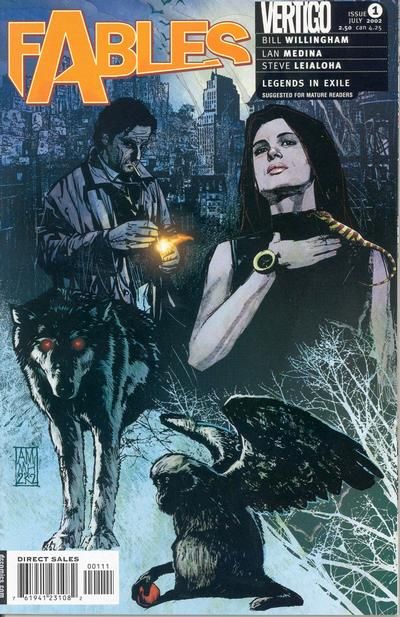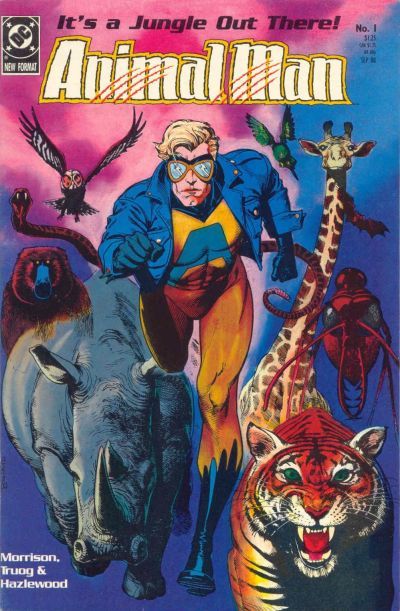Here's the next five runs (as voted upon by about 700 Comics Should Be Good readers).
Enjoy!
25. Dave Sim and Gerhard's Cerebus - 370 points (8 first place votes)
Cerebus #1-300 (Gerhard from #65-300)
Dave Sim's Cerebus, which stars the short grey-skinned anthropomorphic aardvark, Cerebus, originally debuted as, if not a take-off, at least similar in tone to Steve Gerber's Marvel comic, Howard the Duck, in that it was an anthropomorphic animal used for satirical purposes. In the original storyline in the late 1970s, Conan the Barbarian was the main target, although other pop culture figures were featured. Cerebus was a hard-living mercenary with little morality who got involved in various adventures.
This changed with the second storyline, the 25-part epic, High Society, where Cerebus gets involved with politics, applying his rough and tumble style to the world of, well, high society. Through this, he ends up becoming Prime Minister, although that does not exactly work out, leading to the massive two-part epic, Church & State, which took about 60 issues, and involved Cerebus becoming Pope.
These stories saw a change in the series to becoming one of the most intelligent ongoing comic book series out there, with a great deal of wit and wisdom.
The rest of the series 300 issues (Sim noted that he would do exactly 300 issues, with Cerebus dying in the last issue) have a series of slightly-less focused stories, although, as the title continued, the work took on an approach more similar to Sim's own life, which included heavier religious overtones, plus specific attacks upon feminism/homosexualism.
From #65 on, Sim drew the book with artist Gerhard, whose detailed backgrounds were absolutely stunning, and became a major attraction of the series.
Cerebus never stopped doing parodies, though, and throughout the run, comics and pop culture and life, in general, were given parody treatment (The Punisher and Sandman being two notable examples).
In 2004, the series ended, as promised, with issue #300.
Sim is currently set for a new comic book series!!
24. Garth Ennis' Punisher - 389 points (5 first place votes)
The Punisher #1-12, The Punisher #1-37, Punisher MAX #1-current (#56) plus Punisher: Born #1-4 and a bunch of one-shots
As famous as the Punisher is, do note that when Garth Ennis took over the character, Marvel was not even PUBLISHING a Punisher comic, and the last revival attempt involved the Punisher working as an Avenging Angel for Heaven fighting against demons with supernatural weapons.
So Garth Ennis was taking on a bit of a challenge when he and fellow Preacher creator, Steve Dillon, took on the character in 2000 with an initial 12-issue mini-series, "Welcome Back, Frank," which quickly dispensed of the Angel approach, instead bringing a dark sense of humor to the comic. The result was a sales success, and Ennis and Dillon (and later a series of other artists, including Ennis' fellow Hitman creator, John McCrea) continued the humorous approach on a Punisher ongoing series, with diminishing results, until the series ended after 37 issues. Then Ennis' greatest work with the character began, with the creation of Punisher MAX, a serious look at the character, which (since it is a MAX title, or otherwise, an R-Rated comic) included a great deal of graphic violence and graphic language, but also a great deal of stunning character work (with new supporting characters added to the cast), engaging storylines, and a rich connected story that, with Ennis' run now coming to a close, the whole 60 issue or so run reads like one big story.
It is a fascinating, and powerful work.
The artwork for the series has been by a few different artists, but mostly Leandro Fernandez and Goran Parlov.
Reader David Germano (who, sadly, refused to let me post his phone number and SSN here) gave me his reasons for why Punisher was his #1 choice...
I'm going to start this out by admitting that Garth Ennis ranks among my favorite authors, comics or otherwise, and is the main reason I'm still reading comics today. I will always love and respect the work of Gaiman and Moore, but it was Preacher that got me back into reading comics and invested in the idea of serialized storytelling, and almost all of my comics collection of the past 10 years can be traced back to the day I picked up the first two trades of Preacher on a whim.
That said, for me, Punisher MAX is Ennis's masterpiece. It's some of the tightest, best-paced writing he's ever done, and despite not having a single artist to define the run, he's had an amazing group of artists to work with, ranging from lesser-known artists like Leandro Fernandez and Goran Parlov - who turn in some of the best work of their careers here - to legends like Howard Chaykin, Richard Corben, and even John Severin.
It was a hard decision for me to come to, because I've loved the experiences of reading and rereading Preacher, Hitman, and much of Ennis's canon again and again, and much of what I loved about those series was their overall sense of hope. Preacher ends with all of its protagonists escaping their past and finding redemption. Tommy may die at the end of Hitman, but he dies without compromising his principles, he dies with his closest friend, and he finally finds a kind of peace. By contrast, Punisher is a series devoid of hope. Frank Castle is a man who willingly places himself beyond redemption, who endeavors to bury anything human inside himself. What sets it apart is that moreso than any other of Ennis's work, I've found myself unable to stop thinking about the series whenever I put an issue down.
Ennis takes what should be a one-note character and mines a surprising amount of depth and poignancy from what could in lesser hands be little more than a murderous caricature. We see sides of Castle rarely seen before in such installments as Born and The Tyger, which show Castle's upbringing and his first steps down the path leading him to become the Punisher (and just who was it Frank said "yes" to?) Meanwhile, we see poignant flashes of humanity and the life Frank left behind in such arcs as Mother Russia, and The Long Cold Dark, not to mention last two pages of The Slavers (which show the life left to a woman freed from the titular villains, and to this day they rank among the most heartbreaking sequences I've ever seen in comics.)
This is a relentlessly dark series, largely devoid of the humor that made the carnage of Ennis's previous Marvel Knights runs of Punisher more palatable, but not entirely without comedy. Kitchen Irish and Barracuda both touch on the black humor Ennis is famous for, although admittedly interspersed with far more disturbing violence. Meanwhile, on the more somber side of the series, Man of Stone ranks up there with Ennis's Avatar series 303 as the closest he has come to capturing the tone of Cormac McCarthy, of whom Ennis is an admitted fan. After the massive shootout that we have been expecting comes early, the sudden, anticlimactic brutality that exemplifies the deaths of all the major and players both satisfies and cheats our expectations for them. We know they are going to die, but we never expect how random, how inevitable, and how ultimately unsatisfying those deaths are. Varick, an outsider to this world, is killed before he can even start to pursue his expose on Zakharov, Dolnovich dies before he even knows the fight between him and Rawlins has begun, Zakharov is crippled by Rawlins and killed with a rock by Frank, and O'Brien is randomly killed by a landmine. Even Rawlins, one of the most heinous recurring villains of the series to that point, dies on a bathroom floor, unable to comprehend how he could find himself in a situation he couldn't talk his way out of. As in McCarthy's No Country for Old Men, we are shown a world of violence, where anyone who participates must pay the price, with Frank as a barely sympathetic version of Chigurh, the force of nature that persists on, walking away from everything at the end of the day regardless of wounds.
And among the darkness and sheer brutality of this series, we are shown again and again that only Frank Castle can live this life, only he can deal with this darkness. Widowmaker and The Long Cold Dark serves as a series of unrelentingly brutal tales that remind of us just how dark, just how horrible this world is, and just what kind of a person Castle has to be to deal with it. Widowmaker shows Budiansky and Jenny Cesare's reactions in the face of Castle's world and their own struggles to deal with their desires for vengeance in the face of their lives being destroyed. Jenny embraces it to the point of self-destruction and Budiansky turns away from it to find some small measure of hope with what is left of his life, but tellingly, both of their final lines of dialogue are rejections of Frank's quest. Meanwhile, The Long Cold Dark features what is in my mind the greatest cliffhanger I've ever read (nothing I've experienced in reading comics can compare to waiting a month between issue #52 and #53,) and both series take their conclusions to unimaginable acts of violence, whether it be Jenny Cesare's killing of Annabella Gorrini or Frank's execution of Barracuda. The darkness, the violence of this world demands extreme measures, and Frank's ability to thrive in this world is made all the more poignant by O'Brien's presence tying Punisher MAX to Hitman. This is the same world of that killed Tommy Monaghan because he clung to his humanity, and the precise reason why Frank Castle survives in it is because of his drive, his constant endeavors to be something less than human.
Finally, with The End, Ennis takes the series and the character to its inevitable conclusion, as Frank Castle kills the members of an Illuminati-like society, single-handedly bringing the extinction of the human race following a nuclear war.
It's a dark, ugly series for a dark, ugly world. It's violent, thought-provoking, and ultimately heart-breaking. With his run on The Punisher MAX, Ennis and his collaborators has given us a front row seat to the heart of darkness and the definitive comic book portrait of the urban vigilante.
Thanks, David!
23. Warren Ellis and Darick Robertson's Transmetropolitan - 418 points (11 first place votes)
Transmetropolitan #1-60
Originally a part of a failed new line of comics (Helix), Transmetropolitan was soon the only comic left standing, and moved to Vertigo, where creators Warren Ellis and Darick Robertson told the adventures of journalist Spider Jerusalem (a tribute to the founder of "gonzo journalist," the late Hunter S. Thompson) for five eventful years.
The basic concept of the series was simple - famed writer Spider Jerusalem has disappeared for five years, living a hermit existence, until the money he was paid in advance for writing two books dries up, and since he doesn't have the books written, to avoid lawsuits, he returns to his job as a journalist to support himself while he finishes the books - and in the process, becomes involved in the life of The City once again.
The book is set in the future, although most of the events of the comic shadow events of the past, usually events from when Thompson first began reporting (so the late 60s/early 70s). Jerusalem has two female assistants who he refers to as his "filthy assistants." The series is mostly built around the audience enjoying Jerusalem, so here is the explanation reader Camilio Maheca gave for why Spider was his #1 pick in the Top Characters vote I had last year:
Well...Spider is the only cynic who can afford to give a damn, a sick miserable bastard that nobody should like (but hell...you can't help but like him, he's fun to watch). Screw the role models; in a future that smells as bad as our present, he represents the piss-off voice of the people who cant speak for themselves, (usually in a blasphemous fashion)
The series ended with a very cool twist ending.
22. Bill Willingham's Fables - 428 points (6 first place votes)
Fables #1-current (#71)
Fables is Bill Willingham's epic story concerning the adventures of the inhabitants of Fabletown, all characters who come from fairy tales and folklore, like Snow White, the Big Bad Wolf, Little Red Riding Hood, etc.
They live in Fabletown because they were driven out of the magical world that they used to live in (called the Homelands), by an evil villain known as the Adversary, who has conquered most of the Homelands.
The early stories followed mostly Snow White, who was the aide to the Mayor of Fabletown (Old King Cole) and Bigby Wolf (the Big Bad Wolf), who was the Sheriff of Fabletown, and their Sam and Diane relationship.
Later storylines revolve around the inevitable war between Fabletown and the Adversary's forces.
While the storylines of the book result in the basic framework of the comic, the key to the book is the character work that writer Bill Willingham does with the characters. To this end, he was greatly helped by the addition to the book of artist Mark Buckingham with the second storyline (with some breaks here and there, Buckingham has remained the artist of the book ever since), whose attention to characterization is perhaps his greatest artistic talent.
Willingham slowly develops characters, and moves them from small roles to big roles without any real warning, so pretty much every character in Fables could be considered the star of the book. In fact, Snow White and Bigby Wolf are currently relatively minor characters in the comic after being the clear leads for the first part of the title.
The book is currently gearing up for a major storyline, so now wouldn't be a bad time to start picking it up!
21. Grant Morrison's Animal Man - 430 points (13 first place votes)
Animal Man #1-26
When Grant Morrison started on Animal Man, the character was such a minor hero that even Morrison's intriguing take on the character was only approved for a four-issue mini-series. However, once the series came out, the response was so positive that it was quickly turned into an ongoing series, which Morrison would work on for 26 issues, with artwork by Chas Truog and Tom Grummett (in some of his earliest comic book work!).
The two most remembered aspects of Morrison's run were his work with environmentalism (which Animal Man, who gains his powers by a connection to animals, was obviously a big proponent of) and metafiction.
The former led to the classic issue where Animal Man is about to kill a guy who was mass-murdering animals, until a dolphin saves him, explaining that dolphins don't believe in revenge. During these early issues, Morrison also had Animal Man encounter a number of other animal-themed heroes, such as Vixen, B'wana Beast and Dolphin.
The latter led to the concluding arc, which involved characters in limbo, the acknowledgement that DC's Crisis had actually happened and that there used to be a different continuity, and even an introduction between Animal Man and Morrison himself, who discussed the problems Morrison had given Animal Man during the series.
Probably the backbone of the series, though, was Animal Man's status as an "Everyman" figure. Buddy Baker had a wife and two children, and he was a lot more normal than other superheroes (which is presumably why Morrison tried to downplay Animal Man becoming a member of Justice League Europe).
By the time Morrison was finished, he took a hero who was so forgettable that he was even in a group CALLED the Forgotten Heroes, and made him a stalwart member of the DC Universe.
That's it for today! More runs tomorrow!!






